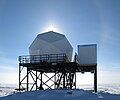Tracking and Data Relay Satellite
The Tracking and Data Relay Satellites ( TDRS ) ( English for Kursverfolgungs- and Data Relay Satellite ) form a network of communications satellites that from NASA and other US -Regierungsbehörden to communicate to satellites, for space shuttle and International Space Station is used. The system was designed to replace the existing network of ground stations that had supported all of NASA's manned missions until then. The main goal of the development was to increase the time in which spacecraft can communicate with the ground station and to increase the bandwidth.
The first seven satellites were built by TRW , the following by Boeing . A total of twelve satellites were launched, eight of which are actively in use, TDRS-L has been launched but not yet put into operation.
The first TDRS was launched in 1983 from the space shuttle Challenger during its first mission, STS-6 . An Inertial Upper Stage , built by Boeing, was supposed to move the satellite from Challenger's orbit into geostationary orbit, but it didn't work properly. Therefore, the on-board control engines had to be used to reach the desired orbit. The service life was reduced due to the increased fuel consumption. Therefore, the satellite was only partially used to support communication over the Antarctic and was decommissioned in October 2009.
The second satellite was lost during the tenth Challenger launch when the space shuttle exploded shortly after launch on its mission called STS-51-L (see Challenger disaster ). The next five TDRS were later launched by various space shuttles. The successors took off into space with Atlas rockets . A NASA press release describes the capabilities of the new system as follows:
"Working solo, TDRS-1 provided more communication coverage, in support of the September 1983 Shuttle mission, than the entire network of NASA tracking stations had provided in all previous Shuttle missions."
analogous translation:
"Working alone, the TDRS-1 ( TDRS A ) satellite was able to handle more data transmission during the shuttle mission in September 1983 than the entire network of NASA's ground tracking stations during all previous shuttle missions."
The transmission systems of the TDRS satellites were developed for the simultaneous transmission of several data streams. Each satellite has systems for transmission in S-band , Ku-band and Ka-band on board in order to enable different data rates. The second generation satellites built by Boeing are capable of carrying more connections than the old satellites built by TRW.
In December 2007, NASA placed the order for two third-generation TDRS satellites with Boeing. These satellites, which are to be launched from 2013, largely correspond to the second-generation satellites, but have more powerful solar generators and improved electronic components. A third satellite in this series was ordered in November 2011.
Start sequence
The satellites are numbered alphabetically before the start and with numbers after a successful start.
1st generation
- TDRS A (TDRS 1) was launched from STS-6 on April 4, 1983 . Decommissioning October 2009
- TDRS B was January 28, 1986 aboard STS-51-L destroyed
- TDRS C (TDRS 3) on 29 September 1988 by STS-26 launched from
- TDRS D (TDRS 4) was launched from STS-29 on March 13, 1989 . Decommissioning December 2011
- TDRS E (TDRS 5) on 2 August 1991 by STS-43 launched from
- TDRS F (TDRS 6) on 13 January 1993 by STS-54 launched from
- TDRS G (TDRS 7), the replacement for the lost TDRS B, was on 13 July 1995 by STS-70 launched from
2nd generation
Based on the proven commercial satellite bus Boeing 601.
- TDRS H (TDRS 8), the first built by Boeing satellite, was on 20 January 2000 with an Atlas IIA started
- TDRS I (TDRS 9) was launched on March 8, 2002 with an Atlas IIA
- TDRS J (TDRS 10) was launched on December 10, 2002 with an Atlas IIA
3rd generation
Like the second generation satellites, they are based on the Boeing 601 satellite bus.
- TDRS K (TDRS 11) was launched on January 31, 2013 with an Atlas V 401.
- TDRS L (TDRS 12) was launched on January 24, 2014 with an Atlas V 401.
- TDRS M (TDRS 13), launched on August 18, 2017
- TDRS N (optional)
gallery
Web links
- NASA: Tracking and Data Relay Satellite (TDRS)
- Goddard Space Flight Center: SN Fleet Operations
Individual evidence
- ^ Pioneer NASA Spacecraft Celebrates 20 Years of Service . NASA press release dated April 3, 2002.
- ↑ Boeing to Build NASA's Newest Tracking and Data Relay Satellites ( Memento from December 24, 2007 in the Internet Archive )
- ↑ Spaceflight Now: TDRS-M data relay satellite purchased for NASA network
- ^ William Graham: ULA Atlas V launches TDRS-M out of Cape Canaveral. nasaspaceflight.com, August 18, 2017, accessed August 18, 2017 .
- ↑ Detailed Mission Data. NASA, archived from the original on February 17, 2013 ; Retrieved July 18, 2012 (English).






